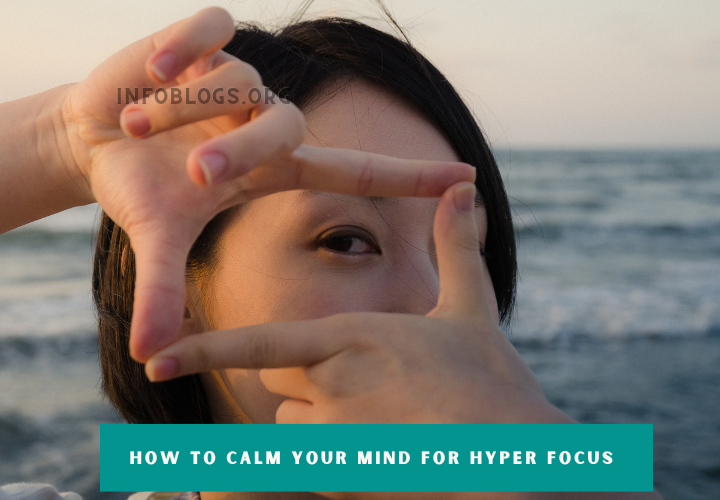If you learn how to focus your mind on a single thing then you will run on the path of success. Today we learn how to calm your mind for hyper focus.
Hyper focus is a state of mind where you can focus on one task with complete concentration. It is often seen as a superpower, as it allows you to achieve high-quality results in a short amount of time. To enter this state of mind, one must first calm their mind and clear out any distractions that might cause disruption.
The first step for achieving hyper focus is to eliminate all external distractions such as phones, computers, and noise. It’s also important to maintain good ergonomics and make sure your work area has proper lighting and ventilation. By eliminating these external factors, your body and mind can be at ease when focusing on the task at hand.
Another way to enter a focused state is through mindfulness practices such as meditation or breathwork exercises. These activities help bring clarity and stillness to the mind while allowing us to observe our thoughts without judgment or attachment. Through regular practice of these mindfulness techniques, we can stay focused in our tasks much longer than before while controlling our emotions more effectively when distractions arise.
So let us get into the detail strategies by which we can put our mind into a hyper focus stage.
Recognize Your Triggers
It is important to identify the triggers for your hyper focus and understand why it happens. Some common triggers include stress, anxiety, fatigue, boredom, and hunger. When you recognize these triggers, you can take steps to help manage them before they affect your concentration.
One of the most effective ways to recognize your triggers is to keep a journal of when they occur. Note down any feelings or thoughts that are associated with the trigger as well as what happened right before it occurred. This will give you valuable insight into what situations cause your mind to race and how best to avoid them or prepare yourself ahead of time.
Another way to recognize your triggers is through mindful meditation or breathing exercises. Taking some time out of each day for mindfulness allows you to observe any emotions that come up without judgment and connect with yourself on a deeper level than just noticing surface-level reactions like stress or anxiety. Over time, this practice can help you become aware of potential triggers earlier in the process so that you can find more effective solutions for calming down quickly and efficiently.
Create a Calm Environment
Organization is key to creating a calm environment. Taking the time to organize and declutter your desk, drawers, and shelves can help free up mental space to focus. By removing distraction, you create a calming atmosphere that allows for hyper-focus on the task at hand. Additionally, make sure there are no distractions in sight such as TVs or phones. Put away any items that may pull your attention from your work.
Consider incorporating plants and scents into your workspace. Green plants can help reduce stress and negative emotions while making the area more inviting for productivity. Also, essential oils like lavender can be used to promote relaxation and a sense of mental clarity – perfect for focusing on important tasks! Lastly, make sure to keep the temperature comfortable; being too hot or cold can cause fatigue or headaches which will take away from productivity levels overall.
Practice Mindful Meditation
Mindful meditation is a technique used to gain control of your thoughts and emotions. It involves focusing on the present moment and being aware of your surroundings, feelings, and sensations without judgment. Mindful meditation can help you become more focused, reduce stress, and improve concentration.
To practice mindful meditation, find a comfortable spot in your home or outdoors that is quiet and peaceful. Close your eyes and take several deep breaths to relax your body. Focus on the breath as it enters and exits the body; notice how it feels as it moves through each part of the body. Keep bringing yourself back to the breath when other thoughts arise. Observe each thought without judging or attaching any emotion to them before refocusing on the breath again. Do this for 10-15 minutes per day (or longer if desired) until you feel a sense of calmness come over you.
Another way to practice mindful meditation is through visualization techniques; imagine yourself surrounded by calming symbols such as a beach scene with waves crashing against rocks or a serene forest filled with birdsong – whichever imagery brings you peace will work best for this exercise! Once you’ve chosen an image focus all of your attention on it for several moments allowing any feelings of stress or worry fade away in favor of tranquility. This exercise can also be used whenever needed throughout the day in order to remain focused and centered even during stressful situations!
Exercise for Stress Relief
Exercising can be a great way to relieve stress and refocus your mind. Going for a brisk walk or jog can help clear your head and improve your physical health, as well as reduce tension. Even something as simple as stretching in the morning or evening can help you relax and reduce symptoms of stress. Yoga is also an ideal form of exercise for relieving stress because it combines physical movement with mindful breathing techniques that allow you to stay in the present moment. Additionally, engaging in cardiovascular exercises like running and swimming boosts endorphins which can fight off feelings of depression and anxiety. Engaging in any kind of physical activity is not only beneficial for reducing stress, but it can also help boost concentration and focus while providing a sense of accomplishment after completing the workout.
Take Regular Breaks
Regular breaks provide an important reset for the mind. Allowing yourself to disengage from your tasks and focus on something else can help clear away some of the built-up stress, allowing you to come back to your tasks with a refreshed outlook. Taking a quick break every hour or two helps keep your energy levels high, which in turn helps you stay focused on the task at hand. Taking a walk outside, listening to music, or doing some light stretching can all be good options for short breaks during the day.
If possible, it’s also beneficial to take longer breaks throughout the day. A few times each week, taking an entire afternoon off gives you time away from work and other stresses that can contribute to hyper focus. This is especially true if you’re feeling overwhelmed; taking a step back allows you space to gain perspective and return with renewed mental clarity. During these longer periods of rest and relaxation, activities such as yoga or meditation can help relax both body and mind while still providing a sense of accomplishment when done well.
Get Enough Sleep
Sleep is a critical component to calming your mind and allowing hyper focus. To achieve this, make sure to get at least 7-9 hours of sleep per night in order to restore your body's energy levels and reenergize the brain for the next day. Additionally, try to establish a regular bedtime routine so that your body can learn when it is time for rest. This includes relaxation techniques such as deep breathing or listening to soothing music in order to put your body into a relaxed state before going to bed. Finally, limit daytime naps by only taking short power naps of 30 minutes or less if you are feeling particularly tired during the day as longer naps may disrupt your nighttime sleep pattern.
Conclusion: Regulating Your Mind
Regulating your mind is a process that takes practice and dedication. It's important to create a routine and stick to it, so that you can train yourself to focus better on tasks. Taking breaks throughout the day is also essential for allowing your mind time to rest and recharge. Doing activities like yoga or meditation can help provide some relief from stress, while also helping to reduce anxious thoughts. Finally, it's important to be mindful of any negative thought patterns or beliefs that may be getting in the way of achieving your desired level of focus. Pay attention to how you react when these thoughts arise and work towards replacing them with more positive ones. By developing new thought habits, we can become more aware of our emotions and reactions, which will enable us to better regulate our minds.
We hope that you have learned something about how to calm your mind for hyper focus.


